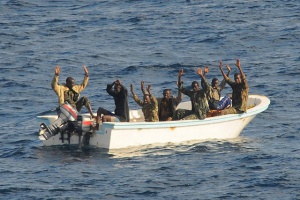Why piracy in Somalia has declined
Analysis |Author: Wanjohi Kabukuru | April 23, 2014, Wednesday @ 09:57| 27111 views
File photo: Somali pirates surrender at sea when a US Navy ship approaches them, February 11, 2009 (Jason R. Zalasky, US Navy)
(Seychelles News Agency) - The continued stability in Somalia, a heavy presence of European and US navies in the western Indian Ocean and a security conscious maritime industry has seen the piracy menace which had plagued this horn of Africa nation reducing to an all-time low.
It is now official that piracy in Somalia waters has declined and overtaken by the pirates operating in the Straits of Malacca in South East Asia and in the West African waters near Gabon, Nigeria, Togo and Benin.
Five years ago Somalia waters were the most dangerous for seafaring vessels which culminated in the 2013 Hollywood thriller Captain Philips starring Tom Hanks in a re-enactment of the failed hijacking of the Maersk Alabama.
According to the Piracy Reporting Centre (PRC) a division of the International Maritime Bureau (IMB) piracy was at its lowest levels in 2013 as a result of the decline in pirate activities in the notorious Somali waters.
“The single biggest reason for the drop in worldwide piracy is the decrease in Somali piracy off the coast of East Africa,” said Captain Pottengal Mukundan, the director of IMB. “It is imperative to continue combined international efforts to tackle Somali piracy. Any complacency at this stage could rekindle pirate activity.”
In its peak piracy had badly affected the economies of the western Indian Ocean nations owing to increases in maritime insurance premiums which were passed to the consumers. The World Bank’s 2013 The Pirates of Somalia: Ending the Threat, Rebuilding a Nation notes that the loss to the global economy as a result of piracy stands at $18 billion with $53 million being collected as ransom by pirates.
Piracy has not just affected the global economy but directly interfered with ocean related livelihoods such as the fisheries sector. According to the Seychelles based Indian Ocean Tuna Commission (IOTC) 26.8 % of the annual tuna catch has been affected by pirates and there have been 100 hijackings in fishing zones with 44 fishing vessels still being held captive.
The World Bank report notes that there has been a 6.5 % tourist drop in the East African coastal and island countries as compared to other sub-Saharan African nations.
The election of political moderate Hassan Sheikh Mohamud in late 2012 as Somalia’s new president and his acceptance by much of Somalia has been one reason that has led to the stabilization of this country.
Since 1992 when Somalia fragmented after the overthrow of the General Siad Barre dictatorship, Somalia has hobbled from civil wars to warlords with little success. Somalia’s scenario was getting worse with the rapid proliferation of piracy whose area of operations stretched over 4 million square kilometres off the Somali coast.
Significant victories and gains over the Al Qaeda linked Somali terror group Al Shabaab achieved by the 9,000 strong African Union Mission in Somalia (AMISOM) in Somalia have also badly affected pirates whose land bases have been severely weakened.
Indeed the threat of resurgence in piracy along Somali waters is still real. Early this month former Scotland Yard detective Simon Davis, who had been hired by the United Nations Office on Drugs and Crime (UNODC), was killed in Somalia’s Puntland region. The killing of Davis was largely seen as an assassination by piracy kingpins, as Davis’ main job was tracking illegal payments to ensure blacklisted terrorist organisation Al Qaeda was not transferring money to finance terrorism.
Statistics availed by the Kuala Lumpur based PRC indicate that in 2011 there 237 piracy related incidents off the coast of Somalia. This number went down to 75 in 2012 and drastically reduced to 15 in 2013. Somalia waters are a vital sea lane with slightly over 25,000 passages annually.
Over the past seven years Somali pirates are said to have collected some $400 million in the form of ransom. West African piracy accounted for 19% of piracy attacks worldwide.
However with the major combat gains made by the African Union troops in mainland Somalia which has led to improved security climate in the Horn of Africa nation has disrupted both piracy and Al Shabaab terror cells. In 2009 there were 130 piracy attacks in the Gulf of Aden resulting in 51 hijackings.
Andrew Mwangura, who is the project coordinator of the East African Seafarer’s Assistance Programme (EASAP) based in Mombasa, Kenya says that the fact that there is low piracy activity does not mean that the standard bearers of the “Jolly Roger” are completely vanquished.
To this day some 50 seafarers are still being held hostage in Somalia.
Even though piracy has been seen in negative light it has interestingly seen the regional countries coming pulling together and coordinating issues on security and intelligence under a single roof. Based in the Seychelles, the Regional Fusion and Law Enforcement Centre for Safety and Security at Sea (REFLECS3) which is the successor of the Regional Anti-Piracy Prosecutions Intelligence Coordination Centre (RAPPICC) has now emerged and it is expected to play a lead role in countering piracy threats while studying new trends of crimes at sea.
Back
